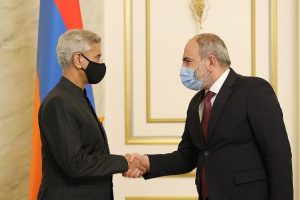On October 13, Ararat Mirzoyan, Armenia’s minister of foreign affairs, hosted his Indian counterpart, Subramanyam Jaishankar, for an official visit. This meeting might be considered a historic occasion – it was the first time in the 30-year history of the Republic of Armenia that the Indian minister of external affairs had visited the nation, despite the amicable relations between the two countries.
While in Armenia, Jaishankar had meetings with the Armenian minister of foreign affairs and Prime Minister Nikol Pashinyan. During the trip, Jaishankar expressed his country’s willingness to deepen ties with Armenia.
Jaishankar was the first Indian foreign minister to visit Armenia, but there have been other high-level visits in the past. In April 2017, a group led by India’s Vice President Mohammad Hamid Ansari paid a visit to the Armenian capital. The Armenian side described it as an exploratory mission, during which New Delhi aimed to learn more about, assess, and make projections about the potential, depth, and directions of possible cooperation with Armenia.
At the time, Armenia proposed a scheme that would allow products to be sent from India to Russia and the Black Sea via Armenia. The idea was linked to the concept of the “North-South Transport Corridor,” which transits through Armenia; India, Iran, and Russia were the original creators of the project.
However, in the aftermath of the meeting, Yerevan’s aspirations were placed on hold for several years. In 2016, India signed a 10-year agreement with Iran to equip and use the Chabahar port in the Gulf of Oman. As a result, for the past few years New Delhi has been focused constructing the first and second rings of the planned chain of ports, a necessary step to link India to the North-South Transport Corridor via Iran.
The recent upheaval in the Caucasus’ political landscape as a result of the Armenian-Azerbaijani war has had an impact on the power balance throughout the region. The first visit to Armenia by an Indian minister of external affairs has to be viewed in this context. The changes underway appear to have attracted India’s attention back to the Caucasus in general and Armenia specifically.
“I was also shocked to find that no Indian Foreign Minister had visited Armenia,” Jaishankar said during his meeting with Armenian Prime Minister Pashinyan. “This was revealed to me when I first met my colleague Ararat Mirzoyan in Dushanbe, and it was a revelation to me. Although what should have happened at the time did not occur, I want to assure you that there is still a great deal of attention being paid to our possible connection now… The current attitude and history of our ties are quite positive, but we must make a tangible effort to advance our relations.”
These developments are taking place in the midst of the formation of a military-political alliance linking Turkey, Azerbaijan, and Pakistan. Therefore, it is probable that New Delhi is beginning to think about creating a geopolitical counterbalance that includes Armenia.
In the meantime, Armenia has announced that an alternate road to Iran will be completed within a month, connecting Iranian ports with Georgian ports via Armenia. This will enable Armenia to sign the “Persian Gulf-Black Sea” agreement with Iran. That brings the North-South Transport Corridor another step closer to reality.
Although time will tell whether or not Jaishankar’s trip to Armenia was fruitful, the essence of the meetings and the views on current developments related to the North-South Transport Corridor that were exchanged in Armenia are beginning to emerge as more distinct visions for India’s foreign policy in the future.

































